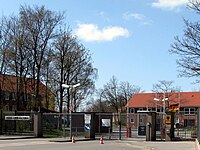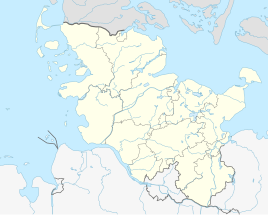Julius Leber Barracks (Husum)
|
|
|||
|---|---|---|---|

Entrance to the Julius-Leber-Kaserne in Husum |
|||
| country |
|
||
| Names | Julius-Leber-Kaserne (since 1961) | ||
| local community |
|
||
| Coordinates : | 54 ° 30 ' N , 9 ° 4' E | ||
| Opened | 1957 | ||
| Stationed troops | |||
| Special Pioneer Regiment 164 5th / ABC Defense Battalion 7th |
|
||
| Formerly stationed units | |||
| Panzergrenadierbataillon 162 Luftwaffe supply regiment 7 1./FlaRakBtl38 3./Nachschubbataillon 6 |
|
||
|
Location of the Julius-Leber-Kaserne in Schleswig-Holstein |
|||
The Julius Leber barracks in the North Frisian district town of Husum is a barracks of the Bundeswehr in Schleswig-Holstein , named after Julius Leber (1891-1945), a member of the Reichstag and resistance fighter . The barracks are located on the western edge of the eastern industrial park on Matthias-Claudius- Strasse. The Husum training area is located to the north of the barracks area.
history
The barracks was built on a former air base of the Luftwaffe , which was built in 1937 and was used for attacks on Scandinavia or night fighters during World War II . After the war, most of the facilities were demolished by the British .
It was not until 1957 that the young Bundeswehr began building barracks on the site. The topping-out ceremony was on May 16, 1958 and the barracks were occupied on March 1, 1959 by five companies of the 162nd Panzergrenadier Battalion. The barracks were named Julius Leber on July 20, 1961.
From April 1, 1959 to September 30, 1992, the 3rd / 6th Supply Battalion was stationed in the barracks. Until 1975 the company was called Ersatzteilekompanie 463 and belonged to the repair battalion 460 from Hamburg.
From June 1963 the staff and the 2nd group of the 7th Air Force Supply Regiment were transferred to the barracks. Flight area control center 4 ( Eider Control ) began operations in mid-1964 . The association received the troop flag in the Dante Stadium in Munich from Defense Minister Kai-Uwe von Hassel on April 24, 1965. The 1st battery of the anti-aircraft missile battalion 38 moved according to the BMVtdg FüL II 2 order of July 8, 1966 to September 20, 1966 Barracks and moved into an accommodation building at the very end of the site and set up the technical area next to the then small-scale shooting range; In 1990 the 1./FlaRakBtl38 was relocated to the now abandoned Prinz-Eugen-Kaserne in Bad Arolsen - Mengeringhausen . On September 1, 1976, a training center for aircraft mechanics, communications electronics and motor vehicle mechanics was set up in Hall 36 of the barracks.
In the course of the air force structure 4, the air force supply regiment 7 was converted into the air force supply battalion 7 and was subordinate to the air force supply regiment 5 in Trollenhagen . Between 2001 and 2003, units took part in the peace operation in the former Yugoslavia . On August 23, 2003, the 7th Air Force Supply Battalion was disbanded. Most of the soldiers were transferred to the 164 Special Engineer Battalion. This was converted into the Special Pioneer Regiment 164 on January 11, 2016.
Stationed units
- Special pioneer regiment 164 with 8 companies
- 5./ABC Defense Battalion 7
- Training workshop of the Air Force Husum
- other small offices
Web links
History of the Julius-Leber-Kaserne in Husum
